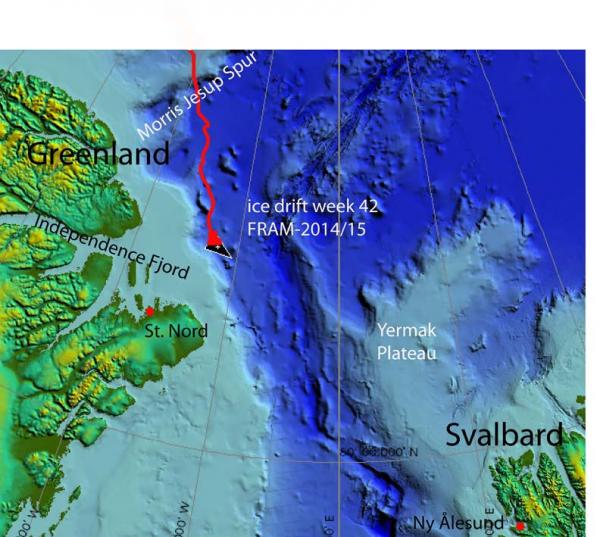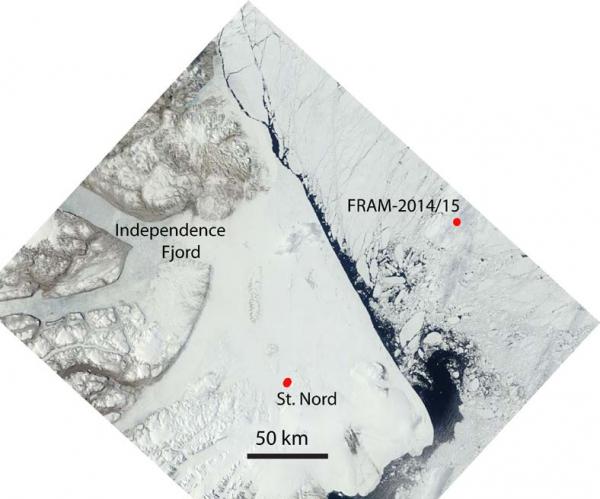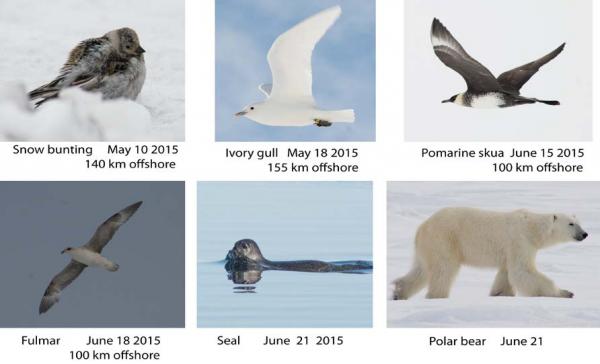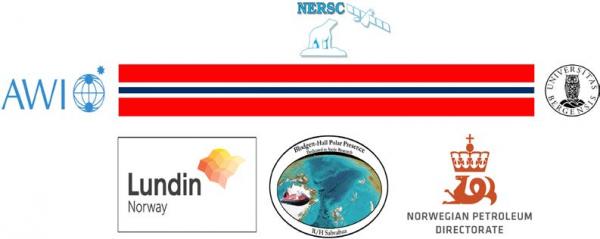
Week forty-two of ice drift (15- 21 June 2015)
Ice drift
The ice camp drifted 16 nautical miles (30 km) along the lower continental slope of Northeast Greenland during the week (Fig. 1). The ice drift remained to the south at 0.1 knot even though winds were from variable directions during the first three days of the week. A weak high pressure over the Norwegian-Greenland Sea and Svalbard gave winds from the southeast during Thursday through Sunday, and ice drift towards the east.

Fig. 1. The drift of FRAM-2014/15 during week 42, 15- 21 June 2015 (short thick red line).
Sea ice dynamics
Starting on Saturday 20 June, the crack right behind the hovercraft first widened to 25 meter and 24 hours later to more than 200 meter Fig. 2. Some of the activity is illustrated by the attached time lapse which covers 14 hours. From the satellite picture (Fig. 3) it is clear we are getting closer to the area of pack ice divergence. On Sunday 21 June, we dismantled the work space and

Fig. 2 The lead behind the hovercraft in the process of widening on Sunday 21 June.

Fig. 3 Satellite image from 21 June courtesy of Danish Meteorological Institute (http://ocean.dmi.dk/arctic/images/MODIS/Nord/20150621TERR.jpg) showing ice distribution and fracture patterns northeast of Greenland.
moved the hovercraft 30 meter away from the lead for the night. The next morning the remaining items were moved across the lead.
Camp life
The past week had two beautiful Arctic days and five days with low visibility or white-out. Temperatures have been above zero degrees (0 , +3) except for Friday (-1 °C). The surface of the snow in the low areas is getting bluish from melt water saturation and will eventually turn into melt ponds. Our daily chores are related to minimizing the impact of the summer melt and positioning cargo in preparation for more ice activity. The wild life has become more diverse. First were the snow buntings, then Ivory gulls, Pomarine skuas, a Fulmar and finally the first polar bear and a seal.
On Sunday, we had to relocate our camp for the fourth time during this nearly ten month ice drift. Relocation in 24 hour light is vastly different from past relocations to the light of our head lamps. We are approaching the area where the ice pack disintegrates and will change the way we operate. We will no longer put up any shelter for work, it is warm enough to do without. No hydro holes will be made. We will collect our cargo on the "best" piece of ice in the neighborhood and use the mobile hovercraft to exploit nearby sites of opportunity for doing the regular CTD casts and deploy the autonomous echo box to obtain bathymetry. In this way, any rapid change in the ice situation will cause minimum disruption. If needed, we have available and checked out two ARGOS trackers which can be used to tag ice floes and follow their position until recovery.
This week, we had to throw away the remaining stock of eggs (c. 40). Finding a good egg was down to one or two out of ten eggs. Our supply of the long term milk has passed its time limit and is also getting hurt by the warm environment. The potatoes have thawed and may still be of use for another week. However, the alternative dry foods are in place so there is little to worry about.
Science
Underway continuous measurements:
Bathymetry:
- Syquest echo box and autonomous data acquisition reporting via Iridium to CMR, Bergen
Oceanography:
- current meter suspended at 150 meter below the ice.
Atmosphere:
- measurement of incoming and outgoing radiation from the ice surface
- surface infrared skin temperature
- sun time
- Aanderaa weather station
Station work
- 2 CTD casts to 1000 meter depth; one every 5 nautical mile
The water depth (c. 3000 m) is out of reach of our remaining Kevlar line (c. 2700 m) so no bottom sampling is possible.
With the need to move our camp, we had to recover our Aanderaa SeaGuard Doppler current meter suspended at 150 meter below the ice from 1 June. To our great surprise there was moisture inside the housing and signs of corrosion. We will need help to attempt recovery of any data.
The autonomous echo sounder box is performing very well and obtains a stable depth value after 2-4 pings. One depth measurement is made every twenty minutes, i.e. every 50-100 meter along the drift track.
Wild life
We saw the first Ivory gull on the 18 May. At that time, the camp was 155 km off the coast of Northeast Greenland. This was the only visiting species until the Pomarine skua arrived on 15 June. A Fulmar was sighted on 18 June. We have for several weeks been about 100 km away from the nearest shore. Sea birds have been present over the camp every day since 7 June and up to 14 individuals. Audun was able to photograph a Pomarine skua wearing a yellow tag with the letter code JN (Fig. 4).
After forty-two weeks on the ice, we sighted our first polar bear - a somewhat scruffy looking individual who went for the food storage. The bear took off when the hovercraft engine was started and did not return.
A seal was sighted in the 200 meter wide lead behind the hovercraft on Sunday.

Fig. 4 Summary of the wildlife observed in camp. Date of first sighting and distance offshore is given.
Life in the High Arctic treats us well.
Yngve Kristoffersen & Audun Tholfsen
Daily reports
Monday 15 June
Position: 82° 41.2' N, 12° 48' W, temperature 0 °C, wind 7 knots from the N. Ice drift 0.05 towards SE. White-out. Woke up to a sound outside. A somewhat scruffy bear was outside the hovercraft. We have been 42 weeks on the ice and this is the sight of a polar bear. The animal walked over to the food storage and started digging for one of the Zarges boxes. We started the hovercraft engine and the bear took off, and we have not seen it since. The AirMar weather station on the hovercraft went down. We consulted Bergen, but did not solve the problem. The melt process is accelerating and ponds are forming around the hovercraft. A pomarine skua was visiting the camp several times.
Tuesday 16 June
Position: 82° 40.64' N, 12° 51.2' W, temperature 0 °C, 1009 hPa, white-out, light rain turning into snow near midnight. No wind and no ice drift. Made a CTD cast down to 1000 meter. Continued work on the weather station issue - the problem was lack of disk space. Files were backed up and moved and the data could then be logged and displayed properly. Continued work cleaning up the sump below the engine in the engine bay. Audun reorganized some of the food.
Wednesday 17 June
Position: 82° 38.23' N, 12° 53.3' W, temperature +3 °C, 1008 hPa, wind 5 knots from the NE. Ice drift 0.1 knot to the S. A glorious day. Audun continued sorting the food. Finished work in the engine bay and cleaned and checked the bilge pumps. Removed about 100 liter of water from the rear flotation tanks. The water is melt water leaking in from above. Pairs of Ivory gulls and Pomarine skuas are visiting the camp. Audun managed to photograph a tagged Pomarine skua. The tag was yellow with capital letters JN.
Thursday 18 June
Position: 82° 36.76' N, 12° 50.8' W, temperature +2 °C, air pressure 1010 hPa, wind 2 knots from the SE. Ice drift 0.0 knot. White-out.
Friday 19 June
Position: 82° 36.16' N, 12° 43.5' W, temperature -1 °C, pressure 1010 hPa, wind 8 knots from the SE. Ice drift 0.1 knot towards the E. White-out until 0200 hours, then clearing and later a beautiful day. Moved cargo to higher ridges to avoid melt pond formation. Made a new small hydro hole for the CTD, because the main hole is getting contaminated. Audun is organizing some of the equipment in boxes. Had to throw out the remaining eggs - about 40. We have visits by Ivory gulls all day.
Saturday 20 June
Position: 82° 37.1' N, 12° 31.6' W. Temperature 0 °C, air pressure 1014 hPa, wind 7 knot from the SE. Ice drift 0.1 knot towards the E. White-out conditions. Checked the radiation flux instrument - battery is 12.57 volt. Checked echo box battery
12.35 volt. Moved six more boxes over to pallets on higher ground. The lead behind the hovercraft opened to 25 meter and the old refrozed and later pressured lead 35 meter in front of the hovercraft opened 1-2 meter. Had the generator running from lunch time on to make hot water for a shower in the evening. We are starting to see the contours of melt ponds on the snow covered ice surface.
Sunday 21 June
Position: 82° 35.8' N, 12° 19.8' W, temperature 0 °C, air pressure 1018 hPa, wind 4 knots from the SE. Ice drift 0.15 knot to the SE. A beautiful day with no clouds. The lead behind the hovercraft skirt widened to over 200 meter during the night. Made a CTD cast to 1000 meter depth. We are at the very edge of the floe and will be in danger if the ice comes together and ice pressure occurs. Started pulling down the tent and the work space and loaded onto the hovercraft. We moved the hovercraft30 meter away from the edge. Audun redetermined the hovercraft azimuth to 255 degrees - a change from 260 degrees measured 10 June.

